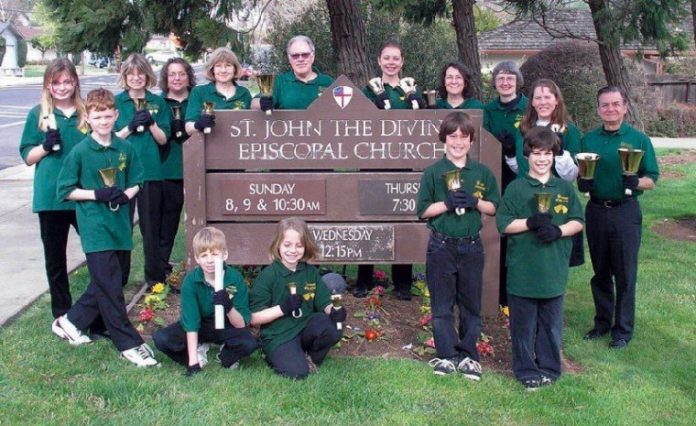When people think of bells in connection with church, they
probably first think of
”
church bells,
”
those large bells hung in towers and rung to summon the
congregation to worship. Or, they may even think of the
”
sacring bells
”
(often called
”
sanctus bells
”
) rung within Roman Catholic and some Episcopal churches to call
attention to the most significant moments during the celebration of
the Mass.
When people think of bells in connection with church, they probably first think of “church bells,” those large bells hung in towers and rung to summon the congregation to worship. Or, they may even think of the “sacring bells” (often called “sanctus bells”) rung within Roman Catholic and some Episcopal churches to call attention to the most significant moments during the celebration of the Mass.
We are all familiar with carillons, bells hung high in towers upon which tunes are played by means of a keyboard. This type of music was developed in 16th century Holland and quickly spread to Belgium and other parts of Europe. (Today, carillons are often electronically played.)
England developed a unique form of music for its church bells. It was called “change-ringing” and involved playing constantly changing patterns of bells, based upon a mathematical formula which would eventually cover all the possible combinations of bells in the tower.
Church bells can be heard for many miles. (They were also used for alarms, much like our civil defense sirens.) Since neighbors often complained about the prolonged din of practicing, someone developed small practice bells which could be rung indoors with one hand (in contrast to standing in a drafty belfry and tugging on a heavy rope).
Surprisingly, handbells in England didn’t become an important part of church music, but their popularity spread into society so that in 1637 a group of ringers was organized: The Ancient Society of College Youths. Today, handbells are a popular feature of community musical concerts in England.
Handbells came to America in 1844 when P.T. Barnum imported a group of performers from England as one of his circus acts. To make them seem more exotic, he costumed the men as Swiss mountaineers. They were a great success, and some people today still mistakenly associate handbells with Switzerland.
In the 1940s the first liturgical (religious) handbell choir was started in New York City and since the establishment of the American Guild of English Handbell Ringers in 1954, the popularity of this instrument has spread widely.
One South Valley church which has had notable success at establishing a bell choir is Morgan Hill’s St. John the Divine Episcopal Church. The Divine Jubilation Handbell Choir began in 2001 with a set of chimes (a metal musical instrument resembling a tuning fork with the clapper on the outside). This device makes a pleasant sound and is much less expensive than a true handbell. Since then the church has purchased handbells, choir members now ring four “octaves,” a total of 50 bells.
The choir is intergenerational, with ringers from 9 years old to middle-aged adults. The number of ringers varies, reaching a total of 14 in April when they played at two of the parish’s Easter Services. (According to Director Virginia Scott, 11 is a good number for most purposes.)
Rehearsals are held every Monday (September through June) from 7:30 to 9pm. Each person can be responsible for only one or two bells, so the ability to read music, while helpful, is not a necessity. There are several strategies available allowing even new ringers to perform successfully.
Faithful attendance is very important, however. Scott compares a set of bells to a single musical instrument: One missing bell is like a missing key on a piano keyboard.
In April the Divine Jubilation Choir participated in a Spring Ring at Valley Church in Cupertino. This annual event is the high point of the year for the choir as they gathered with more than 200 ringers from churches and organizations throughout the Bay Area to share their love of bell music and increase their skills through classes offered during day.
To learn more about the joy of this special kind of music, call St. John’s Church at 779-9510.












